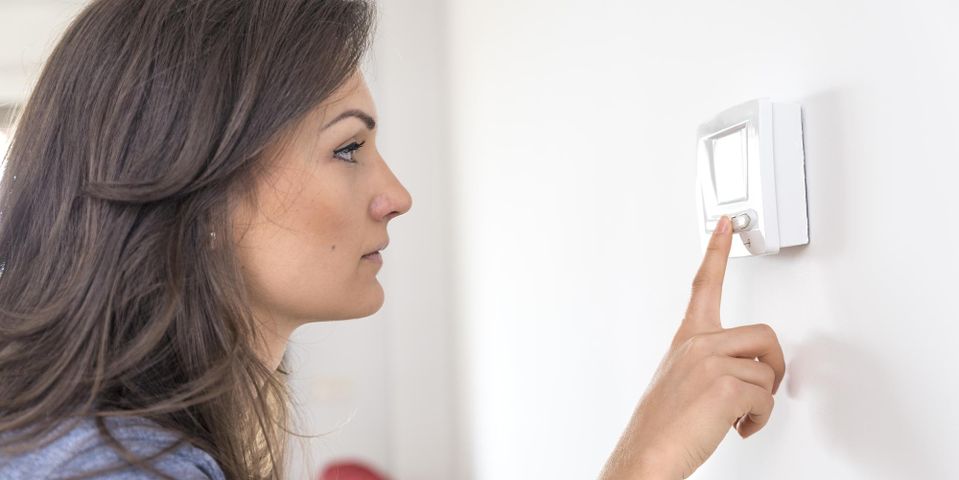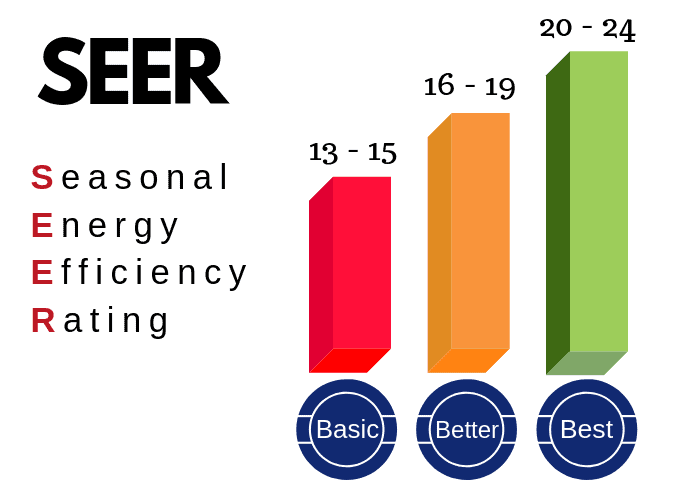What does SEER mean, and why is it important?
SEER stands for Seasonal Energy Efficiency Ratio and is an important consideration if you intend to purchase an air-conditioner.
Making the correct choice based on a good SEER rating will save you money and ensure maximum efficiency in your home or office.

History of SEER and How Does the SEER Rating Work?
What is SEER all about and where did it originate.
Why Was SEER Developed?
The Air Conditioning, Heating, and Refrigeration Institute developed the SEER method in response to energy-related policies decreed in the early 1970s by President Ford. In the 1990s, most cooling units had a SEER rating of 8 or 9. The Energy Policy Act of 2005 enforced upgrades to a minimum SEER of 13. These policies offered suggested energy efficiency standards that are still in use today.
How Does It Work?
Calculated over a typical cooling season, SEER uses the ratio of the unit output divided by the energy required using Watt-hours. In short, the amount of energy that is required to keep a specific area cool. It makes these calculations based on outdoor temperatures ranging from 65°F to 104°F and uses the same set constant indoor return air temperature.
It divides outdoor temperatures into 8 sets of 5º increments. A fraction of the total annual cooling hours is related to each set. It bases indoors the temperature on a set 80º with a 50% relative humidity.
What Does this Mean?

The minimum SEER rating in the U.S. is between 13 and 14, and the maximum rating is usually 21. In warmer areas, it can be higher. The higher the rating, the more efficient the cooling unit, but this also means it costs more.
The US Department of Energy specifies minimum SEER requirements in different regions. The SEER rating in the Southwest and Southeast is 14 and drops to 13 in the North.
A higher rating means lower utility bills and reduced carbon emissions. In certain areas such as Georgia, tax rebates and discounts are offered on higher-rated units.
What Should I Consider When Shopping for a Cooling Unit?
There are several factors to take into account when selecting an effective cooling unit for a specific space. A lower SEER rating does not mean lowered efficiency, but spending more for a higher rated unit can save you in the long run. Things to consider are:
1. Your budget
2. The size of the unit compared to the area of installation
3. The size of the area it needs to cool
4. The climate in your area
5. The time you spend at home
6. How often and how long you will need to run the unit
7. Maintenance options

What is the SEER Rating Range?
We can break the SEER rating range down into 3 categories, single-stage cooling units with a rating of 13 to 18.5 SEER, two-stage units with a rating range of 16-20 SEER, and units with variable-capacity compressors with a SEER rating from 19–26.
13-18.5 SEER
These units run at full capacity continuously, turning on and off more often, causing uneven room temperatures. It does not remove moisture as effectively, and in Summer, this can lead to humid interiors.
16-20 SEER
With two capacities of approximately 35% and then 100%, these units provide better climate and humidity control as it matches them with variable speed blowers.
19-26 SEER
Speed capacity ranges from 25% to 100%, moderating climate and humidity at the correct efficiency level, keeping the space cool and dry.

Other Ratings to Consider
There are two other important ratings to consider when shopping for a cooling unit, namely HSPF and EER.
HSPF stands for Heating Seasonal Performance Factor and is related to the efficiency of heat pumps. These units provide a cool climate in homes by moving hot air from the inside to the outside or warming our homes by moving warm air from the outside to the inside.
This is also calculated by dividing the energy required to heat the space by the watt-hours used and is used to reflect the energy efficiency of the unit.
EER stands for Energy Efficient Ratio and is calculated similarly. However, it does not consider changes in the average outside temperature during the cooling season but rather works on a constant outdoor temperature of 95ºF. It uses the same standard set indoor return air temperature.
Benefits of a Higher SEER Rating
Purchasing a higher SEER rated cooling unit will certainly cost you more, and the energy savings probably won’t make up for the extra money spent. However, we believe that paying more will prove worthwhile in the long run, and here’s why:
A Regulated Temperature
The higher efficiency cooling units usually come standard with a 2-stage cooling and variable speed fan, providing better cooling and energy efficiency. This is because it runs with fewer stops/starts as it works on lower settings, running more frequently.
These stop/starts of the lower SEER units are energy-consuming and result in uneven temperature control. The higher SEER units are also more efficient at removing humidity.
Lower Running Costs
With fewer stops/starts, the cooling unit uses less energy resulting in lower utility bills. There are also taxes and rebates for customers utilizing higher SEER-rated equipment.

How Much Can I Save With Higher SEER Rating?
You can work out your potential cost saving by using the SEER Savings Calculator, which can be found by clicking on the link https://www.seerenergysavings.com/.
This will calculate the savings involved when upgrading your old current unit to a higher efficiency unit, the difference between the lower and higher SEER units, and compare electricity costs.
Your savings will be estimated for 1 year, 5-year, 10-year, and 15-year periods based on the following factors:
- Current air-cooling unit SEER rating
- Size of the unit
- Electricity costs in your state
- Estimated cooling hours in your area
It is possible to save up to as much as 41% annually on a high SEER-rated cooling unit, based on the efficiency of a matched system. If we were to compare a 3-ton, 8 SEER unit to a new 3-ton 16 SEER unit we could work on an assumed electricity cost of $0.14 per kilowatt-hour.

If the unit runs 2100 hours per cooling season you would save $661 per year. Over a period of 20 years, this saving would amount to $13,240.
Similarly, a 16 SEER unit uses about 13% less energy to produce the same amount of cooling as a 14 SEER unit of the same size.
That means that for every $100 you’d pay to run your 14 SEER unit, you could save $13 by upgrading to a 16 SEER unit
The unit would pay for itself in a few years and, due to its energy efficiency, allow substantial energy savings. The hotter the climate the more effective, the higher the SEER-rated unit.
Conclusion
Every cooling space is different, and there is no one right answer as to the perfect cooling efficiency. The higher the SEER number, the more efficient the output, and you could dramatically improve the comfort of your own home and play an important part in reducing carbon emissions and improving our environment.
People Also Ask
If you are planning to buy an air-cooling unit, you must do your homework and make an informed decision. Here are some important frequently asked questions and answers that you should be asking:
Yes, the climate zone does affect the SEER rating. In the U.S., in Northern states, the minimum SEER rating is at least 13, whereas 14 SEER is the minimum in Southern states. This is because the warmer season lasts longer, and air cooling is necessary for longer periods.
There are many considerations, including the SEER, to take into consideration. Factors such as budget, size of the unit, the size of the area it will be placed in, and the climate will also help to select the correct unit. Other factors to consider are other ratings such as HSPF and EER.
A 16 SEER unit usually comes with a 2-stage cooling unit and a variable speed fan and is more efficient in maintaining a comfortable and consistent interior climate. as well as reducing costs in terms of energy use and carbon emissions.
Yes, it does cost more as the higher SEER units come standard with 2-stage cooling and a variable-speed fan, as opposed to the lower SEER units that only offer on and off options.
Yes, high SEER AC units are worth it and depend on the climate in your area. Standard additional features improve their general efficiency in terms of cooling, removal of humidity, and energy used. Though they run more often, fewer energy-draining stops/starts are running at lower settings.
Recommendations have been made by the U.S. Department of Energy based on national energy efficiency standards, enforcing minimum SEER ratings on all units sold and installed. These requirements differ by geographical region.
